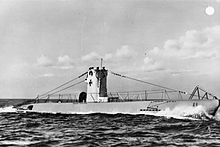Coastal submarine
Space limitations aboard coastal submarines restrict fuel availability for distant travel, food availability for extended patrol duration, and number of weapons carried.
These coastal submarines displaced only 15 to 20 percent the weight of a contemporary conventional U-boat,[2] could be built in one-quarter the time it took to complete a conventional U-boat, and be delivered on railway wagons to operating bases in Belgium.
[3] Improved versions of UB and UC coastal submarines were devised.
These coastal U-boats, with another eight completed prior to hostilities, made North Sea combat patrols during the early months of World War II and then served in the Baltic Sea training crews to operate ocean-going submarines.
[5] The 30th U-boat Flotilla of six Type II U-boats was transported overland on the Autobahn and then down the Danube for combat patrols in the Black Sea until September 1944.



